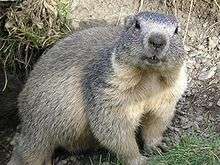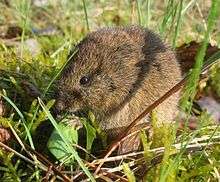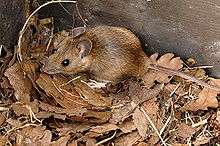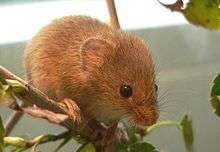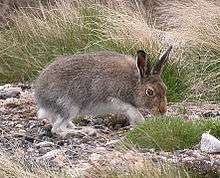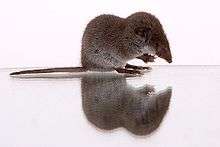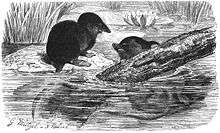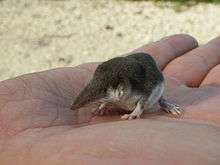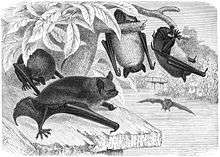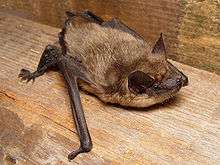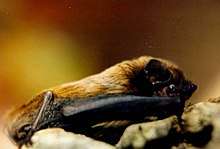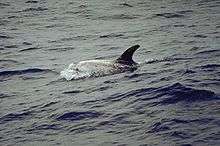List of mammals of Italy
There are 102 mammal species in Italy, of which one is critically endangered, two are endangered, nine are vulnerable, and four are near threatened. One of the species listed for Italy is considered to be extinct. The following tags are used to highlight each species' IUCN Red List status as published by the International Union for Conservation of Nature:
| EX | Extinct | No reasonable doubt that the last individual has died. |
| EW | Extinct in the wild | Known only to survive in captivity or as a naturalized populations well outside its previous range. |
| CR | Critically endangered | The species is in imminent risk of extinction in the wild. |
| EN | Endangered | The species is facing an extremely high risk of extinction in the wild. |
| VU | Vulnerable | The species is facing a high risk of extinction in the wild. |
| NT | Near threatened | The species does not meet any of the criteria that would categorise it as risking extinction but it is likely to do so in the future. |
| LC | Least concern | There are no current identifiable risks to the species. |
| DD | Data deficient | There is inadequate information to make an assessment of the risks to this species. |
Order: Rodentia (rodents)
Rodents make up the largest order of mammals, with over 40% of mammalian species. They have two incisors in the upper and lower jaw which grow continually and must be kept short by gnawing.
- Suborder: Hystricognathi
- Family: Hystricidae (Old World porcupines)
- Genus: Hystrix
- Crested porcupine, H. cristata LC[1]
- Genus: Hystrix
- Family: Hystricidae (Old World porcupines)
- Suborder: Sciurognathi
- Family: Sciuridae (squirrels)
- Subfamily: Sciurinae
- Tribe: Sciurini
- Genus: Sciurus
- Red squirrel, S. vulgaris LC[2]
- Calabrian black squirrel, Sciurus meridionalis NE (endemic to Calabria and Basilicata)
- Genus: Sciurus
- Tribe: Sciurini
- Subfamily: Xerinae
- Tribe: Marmotini
- Genus: Marmota
- Alpine marmot, Marmota marmota LC
- Genus: Marmota
- Tribe: Marmotini
- Subfamily: Sciurinae
- Family: Gliridae (dormice)
- Subfamily: Leithiinae
- Genus: Dryomys
- Forest dormouse, Dryomys nitedula LC
- Genus: Eliomys
- Garden dormouse, E. quercinus NT[3]
- Genus: Muscardinus
- Hazel dormouse, Muscardinus avellanarius LC
- Genus: Dryomys
- Subfamily: Glirinae
- Genus: Glis
- Edible dormouse, Glis glis LC
- Genus: Glis
- Subfamily: Leithiinae
- Family: Cricetidae
- Subfamily: Arvicolinae
- Genus: Arvicola
- European water vole, A. amphibius LC[4]
- Genus: Chionomys
- Snow vole, Chionomys nivalis LC
- Genus: Clethrionomys
- Bank vole, Clethrionomys glareolus LC
- Genus: Microtus
- Field vole, Microtus agrestis LC
- Common vole, Microtus arvalis LC
- Calabria pine vole, Microtus brachycercus LC
- Alpine pine vole, Microtus multiplex LC
- Savi's pine vole, Microtus savii LC
- European pine vole, Microtus subterraneus LC
- Genus: Arvicola
- Subfamily: Arvicolinae
- Family: Muridae (mice, rats, voles, gerbils, hamsters, etc.)
- Subfamily: Murinae
- Genus: Mus
- House mouse, Mus musculus LC
- Genus: Apodemus
- Alpine field mouse, Apodemus alpicola LC
- Yellow-necked mouse, Apodemus flavicollis LC
- Wood mouse, Apodemus sylvaticus LC
- Genus: Micromys
- Eurasian harvest mouse, Micromys minutus LC
- Genus: Rattus
- Genus: Mus
- Subfamily: Murinae
- Family: Sciuridae (squirrels)
Order: Lagomorpha (lagomorphs)
The lagomorphs comprise two families, Leporidae (hares and rabbits), and Ochotonidae (pikas). Though they can resemble rodents, and were classified as a superfamily in that order until the early 20th century, they have since been considered a separate order. They differ from rodents in a number of physical characteristics, such as having four incisors in the upper jaw rather than two.
- Family: Leporidae (rabbits, hares)
- Genus: Oryctolagus
- European rabbit, O. cuniculus introduced, EN in Iberian Peninsula[6]
- Genus: Lepus
- European hare, L. europaeus LC[7]
- Mountain hare, L. timidus LC
- Genus: Oryctolagus
Order: Eulipotyphla (shrews, hedgehogs, gymnures, moles and solenodons)
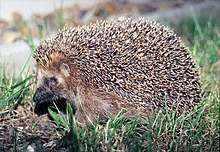
Eulipotyphlans are insectivorous mammals. Shrews and solenodons resemble mice, hedgehogs carry spines, gymnures look more like large rats, while moles are stout-bodied burrowers.
- Family: Erinaceidae (hedgehogs and gymnures)
- Subfamily: Erinaceinae
- Family: Soricidae (shrews)
- Subfamily: Crocidurinae
- Genus: Crocidura
- Pantellerian shrew, Crocidura cossyrensis DD
- Bicolored shrew, Crocidura leucodon LC
- Sicilian shrew, Crocidura sicula LC
- Lesser white-toothed shrew, Crocidura suaveolens LC
- Genus: Suncus
- Etruscan shrew, Suncus etruscus LC
- Genus: Crocidura
- Subfamily: Soricinae
- Tribe: Nectogalini
- Genus: Neomys
- Southern water shrew, Neomys anomalus LC
- Eurasian water shrew, Neomys fodiens LC
- Genus: Neomys
- Tribe: Soricini
- Genus: Sorex
- Alpine shrew, Sorex alpinus NT
- Common shrew, Sorex araneus LC
- Eurasian pygmy shrew, Sorex minutus LC
- Apennine shrew, Sorex samniticus LC
- Genus: Sorex
- Tribe: Nectogalini
- Subfamily: Crocidurinae
- Family: Talpidae (moles)
- Subfamily: Talpinae
- Tribe: Talpini
- Genus: Talpa
- European mole, Talpa europaea LC
- Mediterranean mole, Talpa caeca LC
- Roman mole, Talpa romana LC
- Genus: Talpa
- Tribe: Talpini
- Subfamily: Talpinae
Order: Chiroptera (bats)
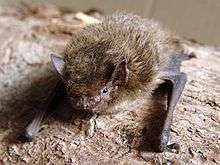
.jpg)
The bats' most distinguishing feature is that their forelimbs are developed as wings, making them the only mammals capable of flight. Bat species account for about 20% of all mammals.
- Family: Vespertilionidae
- Subfamily: Myotinae
- Genus: Myotis
- Long-fingered bat, M. capaccinii VU[9]
- Bechstein's bat, M. bechsteini NT[10]
- Greater mouse-eared bat, M. myotis LC[11]
- Lesser mouse-eared bat, M. blythii LC[12]
- Brandt's bat, M. brandti LC
- Daubenton's bat, M. daubentonii LC
- Geoffroy's bat, M. emarginatus LC
- Whiskered bat, M. mystacinus LC
- Natterer's bat, M. nattereri LC
- Cryptic myotis, M. crypticus NE
- Genus: Myotis
- Subfamily: Vespertilioninae
- Genus: Barbastella
- Barbastelle, B. barbastellus NT
- Genus: Eptesicus
- Northern bat, E. nilssoni LC
- Serotine bat, E. serotinus LC
- Genus: Hypsugo
- Savi's pipistrelle, H. savii LC[13]
- Genus: Nyctalus
- Greater noctule bat, N. lasiopterus NT[14]
- Lesser noctule, N. leisleri LC[15]
- Common noctule, N. noctula LC[16]
- Genus: Pipistrellus
- Nathusius' pipistrelle, P. nathusii LC[17]
- Kuhl's pipistrelle, P. kuhlii LC
- Common pipistrelle, P. pipistrellus LC
- Genus: Plecotus
- Brown long-eared bat, P. auritus LC
- Grey long-eared bat, P. austriacus LC
- Genus: Vespertilio
- Parti-coloured bat, V. murinus LC
- Genus: Barbastella
- Subfamily: Miniopterinae
- Genus: Miniopterus
- Schreibers' long-fingered bat, Miniopterus schreibersii NT
- Genus: Miniopterus
- Subfamily: Myotinae
- Family: Molossidae
- Genus: Tadarida
- European free-tailed bat, T. teniotis LC
- Genus: Tadarida
- Family: Rhinolophidae
- Subfamily: Rhinolophinae
- Genus: Rhinolophus
- Mediterranean horseshoe bat, R. euryale VU
- Mehely's horseshoe bat, R. mehelyi VU
- Blasius's horseshoe bat, R. blasii NT
- Greater horseshoe bat, R. ferrumequinum NT
- Lesser horseshoe bat, R. hipposideros NT
- Genus: Rhinolophus
- Subfamily: Rhinolophinae
Order: Cetacea (whales)
The order Cetacea includes whales, dolphins and porpoises. They are the mammals most fully adapted to aquatic life with a spindle-shaped nearly hairless body, protected by a thick layer of blubber, and forelimbs and tail modified to provide propulsion underwater.
- Suborder: Mysticeti
- Family: Balaenidae (right whales)
- Genus: Eubalaena
- North Atlantic right whale, Eubalaena glacialis CR or Functionally Extinct in European waters[18][19]
- Genus: Eubalaena
- Family: Balaenopteridae (rorquals)
- Subfamily: Megapterinae
- Genus: Megaptera
- Humpback whale, Megaptera novaeangliae LC
- Genus: Megaptera
- Subfamily: Balaenopterinae
- Genus: Balaenoptera
- Subfamily: Megapterinae
- Family: Balaenidae (right whales)
- Suborder: Odontoceti
- Family: Physeteridae
- Genus: Physeter
- Sperm whale, Physeter macrocephalus EN
- Genus: Physeter
- Superfamily: Platanistoidea
- Family: Ziphidae
- Genus: Ziphius
- Cuvier's beaked whale, Ziphius cavirostris LC [22]
- Genus: Mesoplodon
- Sowerby's beaked whale, Mesoplodon bidens DD [23][24]
- Gervais' beaked whale, Mesoplodon europaeus DD (vagrant)[25]
- Genus: Ziphius
- Family: Delphinidae (marine dolphins)
- Genus: Steno
- Rough-toothed dolphin, Steno bredanensis LC
- Genus: Tursiops
- Common bottlenose dolphin, Tursiops truncatus VU
- Genus: Stenella
- Striped dolphin, Stenella coeruleoalba VU
- Genus: Delphinus
- Short-beaked common dolphin, Delphinus delphis EN
- Genus: Grampus
- Risso's dolphin, Grampus griseus DD
- Genus: Feresa
- Pygmy killer whale, Feresa attenuata DD
- Genus: Pseudorca
- False killer whale, Pseudorca crassidens DD
- Genus: Orcinus
- Genus: Globicephala
- Long-finned pilot whale, G. melas DD
- Genus: Steno
- Family: Ziphidae
- Family: Physeteridae
Order: Carnivora (carnivorans)
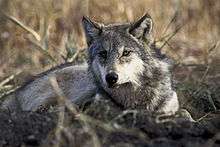
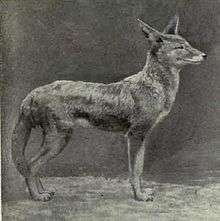

There are over 260 species of carnivorans, the majority of which eat meat as their primary dietary item. They have a characteristic skull shape and dentition.
- Suborder: Feliformia
- Family: Felidae (cats)
- Subfamily: Felinae
- Genus: Felis
- European wildcat, F. silvestris LC
- Genus: Lynx
- Eurasian lynx, L. lynx LC[27]
- Genus: Felis
- Subfamily: Felinae
- Family: Viverridae (civets, mongooses, etc.)
- Subfamily: Viverrinae
- Genus: Genetta
- Common genet, G. genetta LC[28]
- Genus: Genetta
- Subfamily: Viverrinae
- Family: Felidae (cats)
- Suborder: Caniformia
- Family: Canidae (dogs, foxes)
- Genus: Vulpes
- Genus: Canis
- Gray wolf, C. lupus LC[30]
- Italian wolf, C. l. italicus
- Golden jackal, C. aureus LC[31]
- European jackal, C. a. moreoticus
- Gray wolf, C. lupus LC[30]
- Family: Ursidae (bears)
- Genus: Ursus
- Brown bear, U. arctos LC[32]
- Eurasian brown bear, U. a. arctos
- Brown bear, U. arctos LC[32]
- Genus: Ursus
- Family: Mustelidae (mustelids)
- Genus: Martes
- Beech marten, M. foina LC[33]
- European pine marten, M. martes LC[34]
- Genus: Mustela
- Stoat, M. erminea LC[35]
- Least weasel, M. nivalis LC[36]
- European polecat, M. putorius LC[37]
- Genus: Meles
- Eurasian badger, M. meles LC[38]
- Genus: Lutra
- European otter, L. lutra NT[39]
- Genus: Martes
- Family: Phocidae (earless seals)
- Genus: Monachus
- Mediterranean monk seal, M. monachus EN[40]
- Genus: Monachus
- Family: Canidae (dogs, foxes)
Order: Artiodactyla (even-toed ungulates)
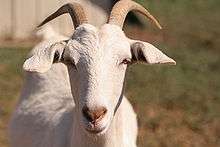
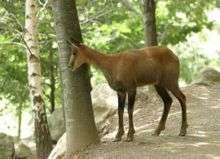
The even-toed ungulates are ungulates whose weight is borne about equally by the third and fourth toes, rather than mostly or entirely by the third as in perissodactyls. There are about 220 artiodactyl species, including many that are of great economic importance to humans.
- Family: Suidae (pigs)
- Family: Cervidae (deer)
- Family: Bovidae (cattle, antelope, sheep, goats)
- Subfamily: Caprinae
- Genus: Capra
- Wild goat, Capra aegagrus VU
- Alpine ibex, Capra ibex LC
- Genus: Ovis
- Mouflon, Ovis orientalis EN
- Genus: Rupicapra
- Pyrenean chamois, Rupicapra pyrenaica LC
- Chamois, Rupicapra rupicapra LC
- Genus: Capra
- Subfamily: Caprinae
See also
References
- Grubb, P.; Amori, G.; de Smet, K. & Bertolino, S. (2010). "Hystrix cristata". IUCN Red List of Threatened Species. 2010: e.T10746A3211666.
- Amori, G.; Hutterer, R.; Kryštufek, B.; Yigit, N.; Mitsain, G.; Muñoz, L. J. P. (2010). "Sciurus vulgaris". IUCN Red List of Threatened Species. 2010: e.T20025A9136220.
- Bertolino, S.; Amori, G.; Henttonen, H.; Zagorodnyuk, I.; Zima, J.; Juškaitis, R.; Meinig, H. & Kryštufek, B. (2008). "Eliomys quercinus". IUCN Red List of Threatened Species. 2008: e.T7618A12835766.
- Batsaikhan, N.; Henttonen, H.; Meinig, H.; Shenbrot, G., Bukhnikashvili, A., Hutterer, R., Kryštufek, B., Yigit, N., Mitsain, G. & Palomo, L. (2016). "Arvicola amphibius". IUCN Red List of Threatened Species. 2016: e.T2149A115060819.CS1 maint: multiple names: authors list (link)
- Kryštufek, B.; Palomo, L.J.; Hutterer, R.; Mitsain, G. & Yigit, N. (2015). "Rattus rattus". IUCN Red List of Threatened Species. 2015: e.T19360A115148682.
- Villafuerte, R.; Delibes-Mateos, M. (2019). "Oryctolagus cuniculus". IUCN Red List of Threatened Species. 2019: e.T41291A45189779.
- Hacklande, K.; Schai-Braun, S. (2019). "Lepus europaeus". IUCN Red List of Threatened Species. 2019: e.T41280A45187424.
- Amori, G. (2016). "Erinaceus europaeus". IUCN Red List of Threatened Species. 2016: e.T29650A2791303.
- Hutson, A. M.; Spitzenberger, F.; Aulagnier, S.; Juste, J.; Karatas, A.; Palmeirim, J. & Paunovic, M. (2010). "Myotis capaccinii". IUCN Red List of Threatened Species. 2010: e.T14126A4399043.CS1 maint: multiple names: authors list (link)
- Paunović, M. (2019). "Myotis bechsteinii". IUCN Red List of Threatened Species. 2019: e.T14123A22053752.
- Coroiu, I.; Juste, J. & Paunović, M. (2016). "Myotis myotis". IUCN Red List of Threatened Species. 2016: e.T14133A22051759.CS1 maint: multiple names: authors list (link)
- Juste, J. & Paunović, M. (2016). "Myotis blythii". IUCN Red List of Threatened Species. 2016: e.T14124A22053297.CS1 maint: multiple names: authors list (link)
- Hutson, A. M.; Spitzenberger, F.; Juste, J.; Aulagnier, S.; Palmeirim, J.; Paunovic, M.; Karatas, A. (2010). "Hypsugo savii". IUCN Red List of Threatened Species. 2010: e.T44856A10955205.
- Hutson, A. M.; Alcaldé, J. T.; Juste, J.; Karataş, A.; Palmeirim, J. & Paunović, M. (2010). "Nyctalus lasiopterus". IUCN Red List of Threatened Species. 2010: e.T14918A4471682.CS1 maint: multiple names: authors list (link)
- Juste, J. & Paunović, M. (2016). "Nyctalus leisleri". IUCN Red List of Threatened Species. 2016: e.T14919A22016159.CS1 maint: multiple names: authors list (link)
- Csorba, G. & Hutson, A.M. (2016). "Nyctalus noctula". IUCN Red List of Threatened Species. 2016: e.T14920A22015682.CS1 maint: multiple names: authors list (link)
- Hutson, A. M.; Spitzenberger, F.; Juste, J.; Aulagnier, S.; Palmeirim, J.; Karatas, A. & Paunovic, M. (2010). "Pipistrellus nathusii". IUCN Red List of Threatened Species. 2010: e.T17316A6966886.CS1 maint: multiple names: authors list (link)
- Monsarrat, S., Pennino, G. M., Smith, D. T., Reeves, R.R., Meynard, N. C., Kaplan, M. D., Rodrigues, L. S. A. (2015). "Historical summer distribution of the endangered North Atlantic right whale (Eubalaena glacialis): a hypothesis based on environmental preferences of a congeneric species" (PDF). Diversity and Distributions. 21 (8): 925–937. doi:10.1111/ddi.12314.CS1 maint: uses authors parameter (link)
- COSEWIC Assessment and Status Report on the North Atlantic Right Whale Eubalaena glacialis in Canada - 2013- Wildlife Species Description and Significance
- Avvistata rara balenottera minore nel Mar di Sardegna
- La prima volta di una Balenottera minore in Sardegna
- https://www.cbd.int/doc/meetings/mar/ebsaws-2014-03/other/ebsaws-2014-03-submission-rac-spa-sr-01-en.pdf
- Rare sighting of white whale in Sardinia
- Frenata la speculazione energetica nel Mar di Sardegna?
- "Mesoplodon europaeus". IUCN Red List of Threatened Species.
- Reeves, R.; Pitman, R.L.; Ford, J.K.B. (2017). "Orcinus orca". IUCN Red List of Threatened Species. 2017: e.T15421A50368125.
- Breitenmoser, U.; Breitenmoser-Würsten, C.; Lanz, T.; von Arx, M.; Antonevich, A.; Bao, W. & Avgan, B. (2015). "Lynx lynx". IUCN Red List of Threatened Species. 2015: e.T12519A121707666.
- Gaubert, P.; Carvalho, F.; Camps, D. & Do Linh San, E. (2015). "Genetta genetta". IUCN Red List of Threatened Species. 2015: e.T41698A45218636.
- Hoffmann, M.; Sillero-Zubiri, C. (2016). "Vulpes vulpes". IUCN Red List of Threatened Species. 2016: e.T23062A46190249.
- Boitani, L.; Phillips, M. & Jhala, Y. (2018). "Canis lupus". IUCN Red List of Threatened Species. 2018: e.T3746A119623865.CS1 maint: multiple names: authors list (link)
- Hoffmann, M.; Arnold, J.; Duckworth, J. W.; Jhala, Y.; Kamler, J. F. & Krofel, M. (2018). "Canis aureus". IUCN Red List of Threatened Species. 2018: e.T118264161A46194820.
- McLellan, B. N.; Proctor, M. F.; Huber, D. & Michel, S. (2017). "Ursus arctos". IUCN Red List of Threatened Species. 2017: e.T41688A121229971.
- Abramov, A.V.; Kranz, A.; Herrero, J.; Krantz, A.; Choudhury, A. & Maran, T. (2016). "Martes foina". IUCN Red List of Threatened Species. 2016: e.T29672A45202514.
- Herrero, J.; Kranz, A.; Skumatov, D.; Abramov, A.V.; Maran, T. & Monakhov, V.G. (2016). "Martes martes". IUCN Red List of Threatened Species. 2016: e.T12848A45199169.
- Reid, F.; Helgen, K. & Kranz, A. (2016). "Mustela erminea". IUCN Red List of Threatened Species. 2016: e.T29674A45203335.
- McDonald, R. A.; Abramov, A. V.; Stubbe, M.; Herrero, J.; Maran, T.; Tikhonov, A.; Cavallini, P.; Kranz, A.; Giannatos, G.; Kryštufek, B. & Reid, F. (2019). "Mustela nivalis". IUCN Red List of Threatened Species. 2019: e.T70207409A147993366.
- Skumatov, D.; Abramov, A.V.; Herrero, J.; Kitchener, A.; Maran, T.; Kranz, A.; Sándor, A.; Stubbe, M.; Saveljev, A.; Savour-Soubelet, A.; Guinot-Ghestem, M.; Zuberogoitia, I.; Birks, J.D.S.; Weber, A.; Melisch, R. & Ruette, S. (2016). "Mustela putorius". IUCN Red List of Threatened Species. 2016: e.T41658A45214384.CS1 maint: multiple names: authors list (link)
- Kranz, A.; Abramov, A. V.; Herrero, J. & Maran, T. (2016). "Meles meles". IUCN Red List of Threatened Species. 2016: e.T29673A45203002.
- Roos, A.; Loy, A.; de Silva, P.; Hajkova, P.; Zemanová, B. (2015). "Lutra lutra". IUCN Red List of Threatened Species. 2015: e.T12419A21935287.
- Karamanlidis, A. & Dendrinos, P. (2015). "Monachus monachus". IUCN Red List of Threatened Species. 2015: e.T13653A45227543.
- Lovari, S.; Herrero, J.; Masseti, M.; Ambarli, H. & Lorenzini, R. & Giannatos, G. (2016). "Capreolus capreolus". IUCN Red List of Threatened Species. 2016: e.T42395A22161386.CS1 maint: multiple names: authors list (link)
External links
- "Animal Diversity Web". University of Michigan Museum of Zoology. 1995–2006. Retrieved 22 May 2007.
